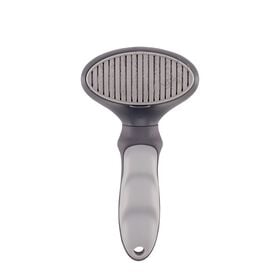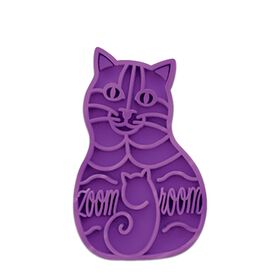Pleasant for some cats and a real nightmare for others, brushing is important, especially for long-haired cats. How can you make brushing your cat enjoyable for all?

Why doesn’t my cat like being brushed?
If your cat overreacts to being handled, it probably had a bad experience or senses something unpleasant. Seeing you arrive with a brush or a grooming accessory in hand, the cat will learn to associate the brush with something unpleasant, which will raise its anxiety level.
Fortunately, you can change your cat’s perception of brushing using a simple technique based on a combination of two principles of conditioning:
- Desensitization: From session to session, gradually expose the cat to the object perceived as unpleasant, while remaining under the cat’s reactivity threshold. In other words, avoid exceeding the cat’s tolerance limit. Otherwise, it will try to run away when the goal is to teach it how to react differently to the object in question.
- Counter-conditioning : Associate the unpleasant item with something pleasant for the animal. Food, such as treats, is often used with this technique.
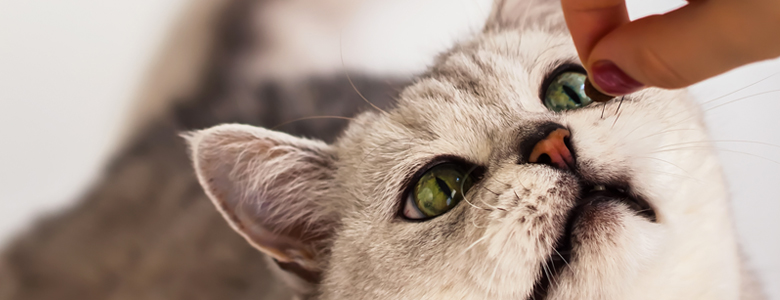
Some cats tolerate grooming if they are fed while being brushed. However, for greater long-term effectiveness and to prevent the cat from making bad associations, treats should be given AFTER the manipulation. It is therefore best to start with short sessions involving several treats and gradually extend the amount of time between treats.
Basic brushing technique
Once the cat stops reacting negatively to being handled and starts looking forward to getting a treat, you can move on to the next step. If signs of stress recur, go back to the previous step until the signs are gone for good. Signs of stress usually recur when you try moving ahead too quickly. It is preferable to avoid long sessions that push the cat’s attention and patience to the limit.
It is also important to choose the same training area and to have treats that your cat enjoys on hand. Place the treats in a pouch attached to your waist or put them in your pocket so that you can easily access them, but your cat cannot.
The technique is simple:
- Perform the manipulation (e.g., touch; brush, one stroke).
- Give your cat a treat.
- Start over. (Each session should last no more than 5 minutes. Avoid exceeding the cat’s tolerance limit.)
It is important to avoid skipping steps. If your cat protests, do the following:
- Quickly touch the cat’s body with the tip of the brush + treat
- Touch the same spot with the flat part of the brush + treat
- Brush lightly in the direction of hair growth + treat
- Increase the length of the single brush stroke + treat
- Brush the same area using two brush strokes + treat
Do the same for all areas of the body, keeping in mind that some, namely the legs and belly, may be more sensitive than others. After several sessions, you should be able to brush the cat’s entire body.
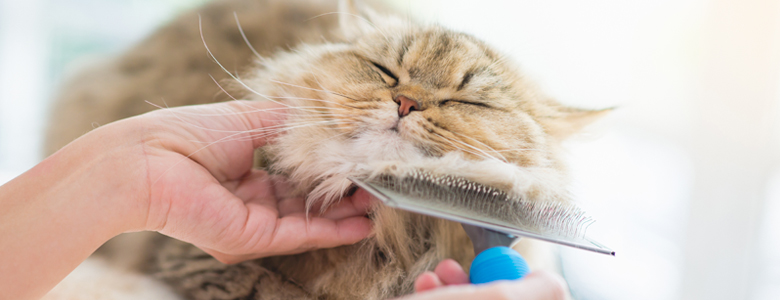
What to do if your cat is difficult
For more sensitive cats, break each step of the desensitization plan into smaller bits, and offer the cat multiple tantalizing treats.
The following are examples of steps broken down into smaller bits to avoid having the cat react negatively. Move on to the next step only once the cat is comfortable and anticipates the treat, looking for it after being handled:
- Show the cat the brush. Give a treat.
- Using the tip of the brush, touch an area where the cat generally likes to be petted for 1 second. Give a treat.
- Touch the same area for 2 seconds, 3 seconds, and so on. Give a treat each time.
- This time using the flat part of the brush, touch the same area for 1 second, 2 seconds, 3 seconds, and so on. Give a treat each time.
- Touch the same area by brushing quickly in the direction of hair growth over a distance of 1 cm, 2 cm, and so on. Give a treat each time.
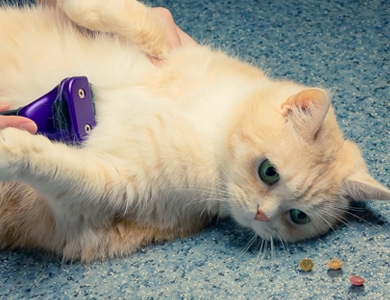
If your cat has fur for which brushing is not enough, you need to seek out veterinary or grooming services. If your cat is very sensitive to pet care and these basic techniques do not seem to encourage its cooperation, you may need a customized desensitization plan developed by a cat behaviour specialist. In the meantime, try your luck. Be patient and have plenty of treats handy!



